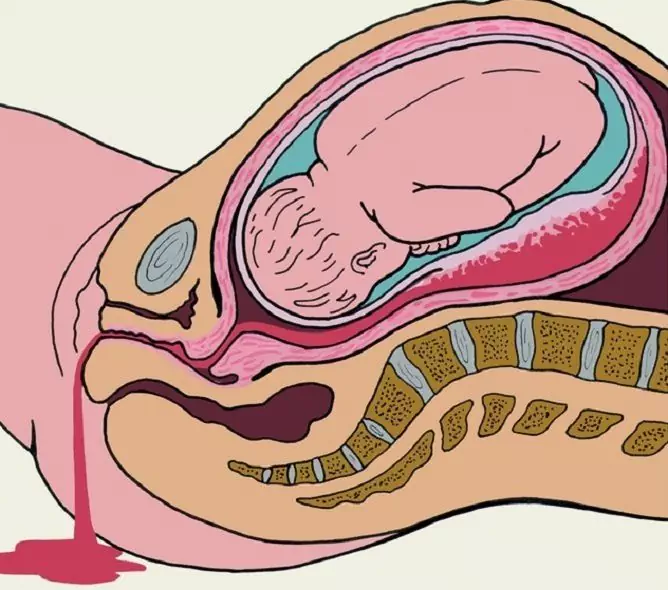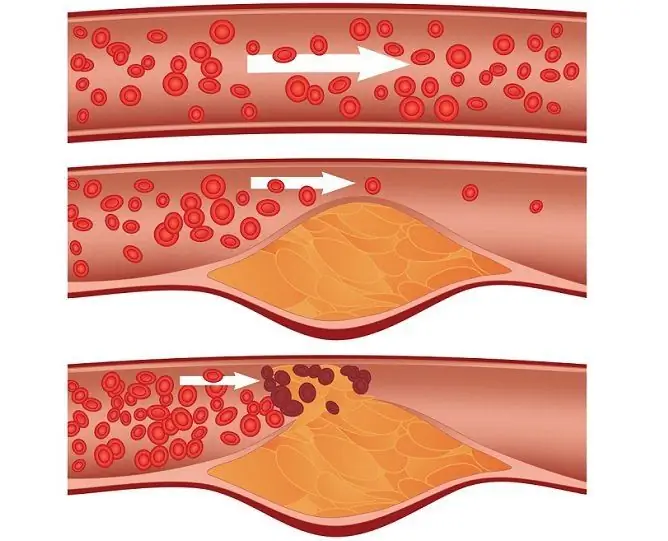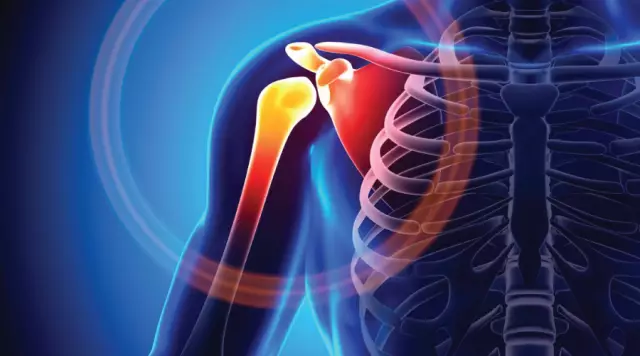- Author Rachel Wainwright [email protected].
- Public 2023-12-15 07:39.
- Last modified 2025-11-02 20:14.
Elbow bursitis
The content of the article:
- Elbow bursitis causes and risk factors
- Forms of the disease
- Elbow bursitis symptoms
- Diagnostics
- Elbow bursitis treatment
- Possible complications and consequences
- Forecast
- Prevention
Elbow bursitis ("athlete's bursitis", "student bursitis") is an inflammatory process that occurs in the synovial bag of the elbow joint. Elbow bursitis is the most common form of all bursitis. Most often, the disease is diagnosed in young and middle-aged people, while men are more susceptible to it.

Inflammation of the sac of the olecranon
The bursa synovialis is a slit-like formation that is delimited from the surrounding tissues by a capsule and contains a small amount of synovial fluid. The synovial bag performs a shock-absorbing function, protects the surrounding tissues from excessive friction and pressure. In the case of excessive load or constant microtrauma in the synovial bag, aseptic (i.e., non-infectious) inflammation develops, while synovial fluid begins to actively develop, which gradually stretches the synovial bag. When an infection is attached, aseptic inflammation turns into purulent, which can spread to neighboring tissues.
In the area of the elbow joint, the subcutaneous ulnar, interosseous ulnar and radioulnar synovial bags are located. In 70-80% of cases, the subcutaneous ulnar synovial bag, which is located in the olecranon process, is affected.
Elbow bursitis causes and risk factors
The main causes of elbow bursitis include:
- rheumatoid arthritis;
- gout;
- allergic processes;
- a sharp increase in physical activity with an overload of the elbow joint;
- injury to the periarticular bursa and tendons.
The development of an infectious process in this case is possible when microorganisms enter through damage with a violation of the integrity of the skin, an abscess or a furuncle in the elbow area. With boils, carbuncles, bedsores, purulent wounds, osteomyelitis, the infectious agent can enter the synovial bag by hematogenous or lymphogenous pathways.

Injury to the elbow charter, excessive physical exertion can lead to bursitis
At risk of developing bursitis of the elbow joint are athletes, persons engaged in heavy physical labor (miners, porters, porters, etc.), as well as workers who, in the course of their professional activities, often lean their elbows on a horizontal surface.
Risk factors include a general weakening of the body after illness, metabolic disorders, prolonged use of steroid drugs, and a tendency to allergies.
The development of chronic bursitis is caused by constant microtrauma of the elbow joint due to excessive load or improper body position.
Forms of the disease
Bursitis of the elbow joint can be acute, subacute and chronic.
Depending on the localization (lesion of a particular synovial bag), bursitis of the elbow joint can have subcutaneous elbow, interosseous elbow and radioulnar forms.
Depending on the nature of the inflammatory exudate:
- serous bursitis of the elbow joint;
- hemorrhagic;
- purulent;
- fibrinous.
Based on the type of infectious agent:
- nonspecific infectious bursitis (caused by staphylococci, streptococci, etc.)
- specific infectious bursitis (caused by mycobacterium tuberculosis, pale spirochete, gonococci, etc.).
Elbow bursitis symptoms
In the case of acute serous or hemorrhagic bursitis, swelling appears in the area of the elbow joint, which is accompanied by slight or moderate pain, hyperemia of the skin and an increase in skin temperature in the affected area, as well as limitation of limb movements in the joint. The general condition of the patient usually suffers slightly. Patients with bursitis of the elbow joint may complain of malaise and an increase in body temperature to subfebrile numbers. In the area of the elbow joint, a limited painful elastic-elastic formation is palpable. In the absence of treatment, a decrease in signs of inflammation with resorption of excess fluid is usually observed, but in most cases this indicates not a recovery, but a transition of the disease to a chronic form.

It looks like bursitis of the elbow joint
Chronic bursitis of the elbow joint can occur against the background of an acute form of the disease or develop primarily. If chronic bursitis of the elbow joint became the outcome of an acute form of the pathological process, the hyperemic skin acquires a normal color (slight cyanosis or darkening of the skin in the affected area is possible), the temperature returns to normal. The painful sensations subside, however, in the future, it can occur when the affected area comes into contact with surrounding objects, during physical exertion and sudden movements. There is a slight limitation of movement in the affected limb. Palpation reveals a painless soft or elastic fluctuating formation. With advanced forms of chronic bursitis of the elbow joint, small seals (the so-called rice bodies) may be palpable in the affected area.
In the presence of a wound surface in the area of the elbow joint, a purulent process in the synovial bursa develops primarily or secondarily, against the background of an acute or chronic form of bursitis of the elbow joint. Symptoms of bursitis of the elbow joint in this case are intense bursting or pulsating pains, swelling, hyperemia of the skin, a sharp limitation of the range of motion (the patient tries to immobilize the arm). Regional lymph nodes increase, weakness and headache increase, body temperature rises to febrile values (39-40 ˚С), and other signs of general intoxication of the body appear. With the further spread of the pathological process in the absence of treatment, fistulas, phlegmon, abscess, purulent arthritis or osteomyelitis can form.
Diagnostics
To diagnose bursitis of the elbow joint, data obtained as a result of collecting complaints and anamnesis, physical examination, as well as a number of additional studies, the volume of which depends on the form of the disease, is used. With the defeat of the ulnar and interosseous ulnar bursae, diagnosis is difficult due to their deep location.
Of the instrumental examination methods for suspected bursitis of the elbow joint, radiography is used (it is not very informative in this case, it serves to exclude other articular pathologies), ultrasound, computed or magnetic resonance imaging. To determine the boundaries of the inflammatory process, angiography is used.

Ultrasound is often used to diagnose bursitis of the elbow
In some cases, a puncture of the bursa is necessary, followed by laboratory examination of the material obtained. When an infectious agent is detected, its identification is carried out with the determination of the sensitivity of the pathogen to antibacterial drugs.
In the general analysis of the blood of patients with bursitis of the elbow joint, signs of an inflammatory process are determined.
If a specific bursitis of the elbow joint is suspected, the patient is referred for consultation to a dermatovenerologist or phthisiatrician, in case of suspicion of rheumatoid arthritis - to a rheumatologist, suspicion of gout is the basis for consulting an endocrinologist.
Elbow bursitis treatment
When treating elbow bursitis, the first step is to minimize stress. In order to limit the range of motion, relieve swelling, and also to reduce pain, an elastic bandage is applied to the affected joint. To relieve pain in an acute inflammatory process, drugs from the group of non-steroidal anti-inflammatory drugs are used, as a rule, locally. In some cases, massage of the affected area with an ice pack is indicated (strictly according to the doctor's prescription, this method is contraindicated in some forms of bursitis).
In order to prevent the transformation of inflammation into a purulent form using puncture, the elbow joint is washed with an antiseptic solution. With pronounced purulent bursitis of the elbow joint, this procedure (with preliminary removal of purulent contents from the articular bag) is repeated until the inflammatory process subsides.

With purulent bursitis, puncture of the elbow charter is performed
In rare cases, as a rule, with a very severe course of the disease, surgical treatment of bursitis of the elbow joint is indicated, which consists in opening and draining the synovial bursa. Such an operation requires long-term postoperative rehabilitation, therefore, it is performed only when other methods did not provide a therapeutic effect against the background of an increase in the inflammatory process.
In chronic bursitis of the elbow joint, also in case of ineffectiveness of conservative therapy, they resort to surgical treatment. Surgical excision of the bursa is performed, followed by removal of adhesions and washing of the joint cavity with an antiseptic solution. In the postoperative period, ultra-high-frequency therapy is usually prescribed.
The stitches are removed approximately on the tenth day after the surgery, after which the patient is shown outpatient treatment and dispensary observation.
Possible complications and consequences
In the absence of adequate treatment, acute bursitis can not only turn into a chronic form, but also lead to the occurrence of pathological processes that can completely destroy the elbow joint with the subsequent limitation of the upper limb mobility up to disability.
Against the background of chronic bursitis, cicatricial adhesions may occur in the elbow joint, leading to a decrease in its mobility.
Forecast
With timely diagnosis and correctly selected treatment, the prognosis for all forms of bursitis of the elbow joint is favorable. In the case of the spread of the pathological process to the surrounding tissues with purulent bursitis (especially in the joint cavity), the prognosis worsens.
Prevention
In order to prevent the development of bursitis of the elbow joint, it is recommended:
- timely treat diseases that can lead to the development of bursitis of the elbow joint;
- avoid excessive physical exertion;
- in the presence of occupational hazards, if possible, reduce the negative impact on the elbow joints (put soft pillows under the elbows, use special protective bandages, take regular breaks from work with a little warm-up).
YouTube video related to the article:

Anna Aksenova Medical journalist About the author
Education: 2004-2007 "First Kiev Medical College" specialty "Laboratory Diagnostics".
The information is generalized and provided for informational purposes only. At the first sign of illness, see your doctor. Self-medication is hazardous to health!






